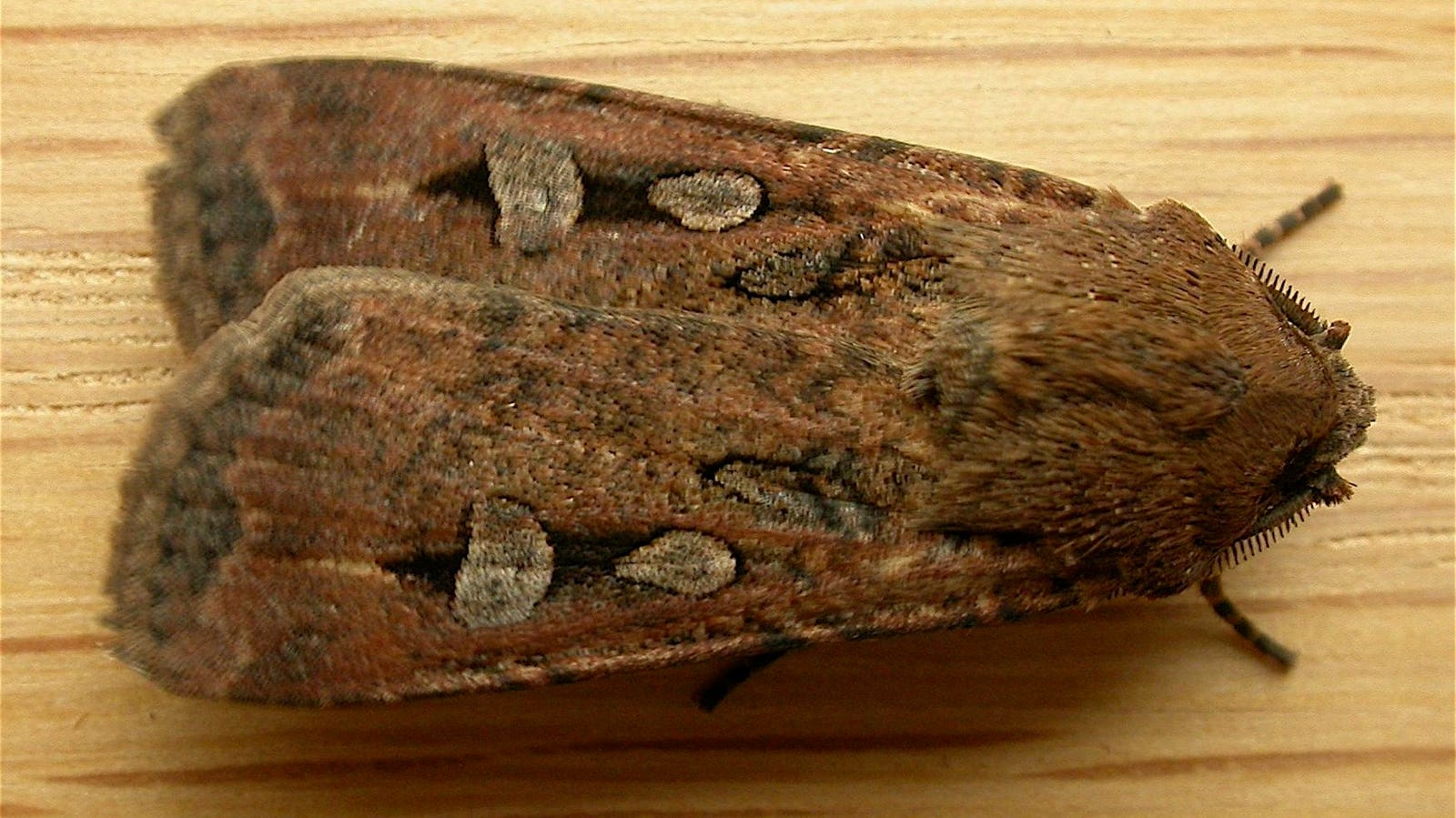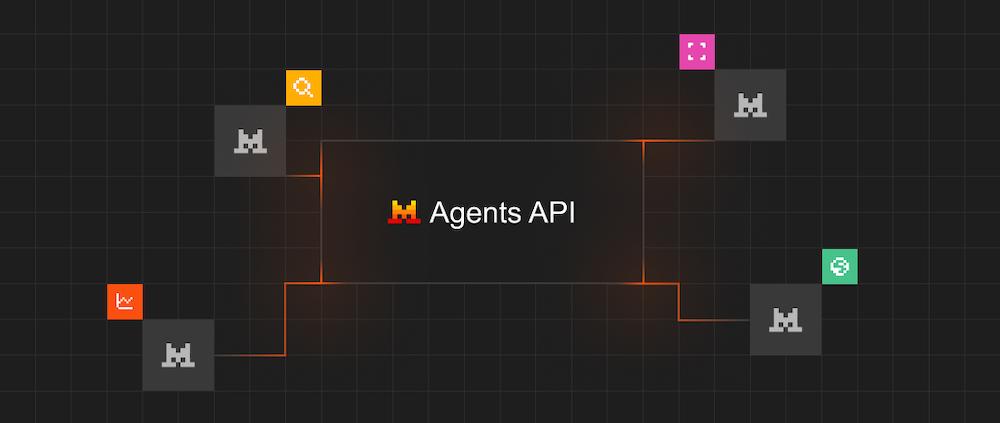Bogong moths navigate 1000 kilometers across Australia to remote alpine caves by following the stars and Earth’s magnetic field.
An adult Bogong moth (Agrotis infusa). (Credit: Donald Hobern / CC BY 2.0)
Donald Hobern via a Creative Commons license
An international team of researchers has found that Australia’s Bogong moth relies on the stars as well as on the Earth’s magnetic field to guide it on its annual migratory journey. An earlier study, published in 2018, established that the moth relies on Earth’s magnetic field to direct its migration (ref). Now, the same team of scientists have revealed that magnetism is just part of the moth’s story.
This small nocturnal moth escapes the extreme summer heat across southeast Australia by migrating up to 1,000 km (621 miles) to a place they’ve never seen before: one of several cool alpine caves in the Snowy Mountains. Once inside the cave, they aestivate over the summer. At the beginning of autumn, the same individuals make a return migration to their breeding grounds where they reproduce and die.
Led by an international team of scientists from Lund University, the Australian National University (ANU), the University of South Australia (UniSA) and other institutions, the research sheds new light on one of nature’s great migration mysteries, involving approximately four million moths each year (Figure 1).
F I G U R E 1 | The Bogong moth life history. a, A male Bogong moth. Scale bar, 5 mm. Photo: A. Narendra, from ref. 2. b, Adult moths migrate from their breeding grounds in various regions of southeast Australia to the Australian Alps during spring (green arrows), where they aestivate in cool alpine caves over summer, and return to the breeding grounds in autumn (purple arrows). At the breeding grounds, they mate, lay eggs and die. Immature stages develop underground during the winter. The red dot indicates the experimental site at Adaminaby. Scale bar, 500 km. c, Around 16,000 moths per square meter aestivate on the walls of specific caves in the Australian Alps for up to 4 months before making the return migration. Inset: close-up image of the moths.
doi:10.1038/s41586-025-09135-3
The Bogong moth, Agrotis infusa, gets its common name from an Australian Aboriginal Dhudhuroa word, bugung, which refers to the moth’s rusty brown coloration. Historically, the Aboriginal Australians were very familiar with these moths’ migratory movements.
“Bogong moths have been a food source for Aboriginal tribes in southeastern Australia, long before Europeans arrived in Australia,” the study’s co-lead author, neurobiologist David Dreyer, a postdoc at Lund University, told me in email. “It is very likely that they understood the migratory nature of the Bogongs since the animals back then would have arrived in spring and would have left at the end of summer, like today, which implies some kind of a migratory movement.”
This moth’s extraordinary navigational abilities have mystified scientists for many decades.
“Ian Common (a famous Australian entomologist who passed away in 2006) noted in the early 1950’s that during the spring migration, flying moths were aligned south to southwest, while autumn moths were aligned north to northeast,” Dr Dreyer added in email. “He also conducted trapping experiments around the migratory routes which revealed a seasonal pattern.”
How do they know which direction to fly in and how do they know when they’ve arrived? Furthermore, is the Earth’s magnetic field the only cue that these migrating moths follow? For example, the Australian bush is famous for its exceptional views of the Milky Way Galaxy, making it a prominent visual landmark for both people and animals; might the moths also rely on following a star map?
Milky Way at Lake Norring, Western Australia. (Credit: Trevor Dobson / CC BY-NC-ND 2.0)
Trevor Dobson via a Creative Commons license
To test this idea, Dr Dreyer and collaborators built a non-magnetic lab in a remote, rural location to prevent any interference from the outside world. Inside this lab, they created simulations of the night sky and recorded the moths’ responses. Dr Dreyer and collaborators were surprised to see that the moths could orient themselves and migrate when they could see the night sky — in the absence of a magnetic field.
When Dr Dreyer and collaborators turned the artificial night sky by 180 degrees, the moths flew in the opposite direction. But when the stars were randomized, the moths just became confused (Figure 3).
F I G U R E 3 | a,b, Images of a laboratory-projected natural night sky during spring and autumn (a), and an autumn sky with its stars randomly arranged (b). c, The orientation directions of migratory moths under naturally oriented night skies, and in a nulled magnetic field, during spring 2018 and 2019 (green vectors, left; n = 70, α = 168°, 95% confidence interval = 58°, R* = 2.014, P = 6.3 × 10−5) and autumn (purple vectors, right; n = 54, α = 341°, 95% confidence interval = 41°, R* = 2.512, P = 9.0 × 10−9). d, As for c, but for night skies rotated by 180° (spring: n = 68, α = 355°, 95% confidence interval = 53°, R* = 2.085, P = 2.7 × 10−5; autumn: n = 56, α = 167°, 95% confidence interval = 69°, R* = 1.716, P = 1.8 × 10−3). e,f, The orientation directions of migratory moths under randomized starry skies during spring (e; n = 58, R* ≈ 0.598, P = 0.35) and autumn (f; n = 49, R* ≈ 0.016, P = 0.91) in 2018 and 2019. All other definitions and statistics are as described in Fig. 2. Bonferroni correction for multiple comparisons was used; corrected P = 6.3 × 10−5 (spring, c) and 9.0 × 10−9 (autumn, c), 2.7 × 10−5 (spring, d) and 1.8 × 10−3 (autumn, d). Sky images in a, Stellarium.
doi:10.1038/s41586-025-09135-3
In addition to following the stars, the study indicated that Earth’s magnetic field acts as a backup navigational aid that the moths follow on cloudy nights when the stars are not visible. But similar to migrating salmon, the moths also appear to use smell to precisely pinpoint the caves in the final stage of their long nighttime journey.
“There is preliminary evidence that they can actually smell the caves, so olfactory cues might guide them on the last meters,” Dr Dreyer told me in email. “Some of the caves are in close proximity to each other, but others are far apart. Sometimes they even hide in boulder fields or just big cracks in the rocks.”
The most important finding of this study is that, after decades of research, scientists are beginning to decipher the migratory behavior of this moth species.
“The Bogong moth is the first invertebrate we know of that is able to use the stars as a compass for long-distance navigation to a distant destination that it has never previously been to,” said the study’s co-lead author, Andrea Adden, a postdoctoral fellow at The Francis Crick Institute, where she is a neuroethologist – a scientist who studies the neural basis of behavior. The Bogong moth research was part of Dr Adden’s PhD at Lund University.
“Only humans and some species of night migratory birds are known to have this ability,” Dr Adden added in email. “Our study is also the first to reveal neurons in the brain that are associated with processing stellar information.”
How Bogong moths interpret these stellar and geomagnetic compass cues so they can successfully follow the desired migratory heading depends on three spatiotemporal factors: the moth’s geographical origin (different breeding populations across southeast Australia migrate in different directions to reach the same target), the season (moths migrate towards the mountains in spring and return to the breeding grounds in autumn) and the time of night (stellar positions change due to Earth’s rotation).
“I guess the most fascinating part about this research is that an insect with a brain that is about the size of a coarse grain of sand — much smaller than a grain of rice — can perform a migratory flight of about 1000km from, lets say, Southern Queensland to a relatively small area in the Snowy Mountains, steering a migratory course over several consecutive nights,” Dr Dreyer told me in email. “Try to do this yourself. The distance between Chicago and Washington DC is about 1000 km. Imagine someone gives you the task to march from Chicago to Washington, just by using the stars as navigational cue at night. You can use the North star, sure, but keep in mind, you have to steer a precise course to hit Washington. We have many many more neurons than insects have, and still, that is a big task for humans.”
Source:
David Dreyer, Andrea Adden, Hui Chen, Barrie Frost, Henrik Mouritsen, Jingjing Xu, Ken Green, Mary Whitehouse, Javaan Chahl, Jesse Wallace, Gao Hu, James Foster, Stanley Heinze & Eric Warrant (2025). Bogong moths use a stellar compass for long-distance navigation at night, Nature 643:994–1000 | doi:10.1038/s41586-025-09135-3
© Copyright by GrrlScientist | hosted by Forbes | LinkTr.ee
Socials: Bluesky | CounterSocial | Gab | LinkedIn | Mastodon Science | MeWe | Spoutible | SubStack | Threads | Tribel | Tumblr | Twitter









